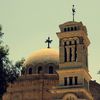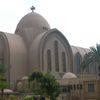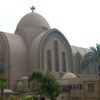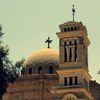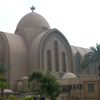10.5.2013 | 15:01
Steve H. Hanke: Dollarize Argentina Now
Steve H. Hanke: Dollarize Argentine Now.Fyrst birt hjį CATO Institute 08. maķ 2013.Steve H. Hanke.Argentina is once again wrestling with its long-time enemy – inflation. Now, it appears history may soon repeat itself, as Argentina teeters on the verge of another currency crisis. As of Tuesday morning, the black-market ARD/USD exchange rate hit 9.87, meaning the peso’s value now sits 47.3% below the official exchange rate.This yields an implied annual inflation rate of 98.3%. For now, the effects of this elevated inflation rate are being subdued somewhat by Argentina’s massive price control regime. But, these price controls are not sustainable in the long term. Indeed, the short-term “lying prices” they create only distort the economic reality, ultimately leading to scarcity.There is, however, a simple solution to Argentina’s monetary problems – dollarization. I have advocated dollarization in Argentina for over two decades – well before the blow up of their so-called “currency board”. To put the record straight, Argentina did not have a true currency board from 1991-2002. Rather, as I anticipated in 1991, the “convertibility system” acted more like a central bank than a currency board. This pegged exchange rate system was bound to fail… and fail, it did.The 2001-02 Argentine Crisis could have easily been avoided if the country had simply dollarized. Argentina had more than sufficient foreign assets to dollarize their economy even late into 2001. But, the Argentine government – through a series of policy blunders – ended up “floating” the currency. Not surprisingly, Argentina is now back to where it was in the late 1980s.So, how can Argentina dollarize? In short, the Banco Central de la Republica Argentina (BRCA) would take all of the assets and liabilities on its balance sheet denominated in foreign currency and convert them to U.S. dollars. The Central Bank would then exchange these dollars for all the pesos in circulation (monetary base), at a fixed exchange rate. By my calculation, the BRCA would need at least $56.36 billion to dollarize at the official exchange rate (as of 23 April 2013).As of April 23, the BRCA had net foreign assets equivalent to $31.23 billion. If Argentina were to dollarize at the official ARD/USD exchange rate of 5.17, it would still fall $25.13 billion short of the $56.36 billion needed to cover the monetary base. That said, if the BRCA were to use an exchange rate closer to the black-market (read:free-market) exchange rate, this could be more easily accomplished.For example, if Argentina decided to dollarize at an ARD/USD exchange rate of 9.33 pesos to the dollar (5.5% lower than the black-market ARD/USD exchange rate as of Tuesday) only $31.23 billion would be required to cover its monetary base and dollarize the economy. This is the exact amount of net foreign assets held by the BCRA (see the accompanying table). |
Meginflokkur: Evrópumįl | Aukaflokkar: Stjórnmįl og samfélag, Utanrķkismįl/alžjóšamįl, Višskipti og fjįrmįl | Breytt s.d. kl. 15:02 | Facebook

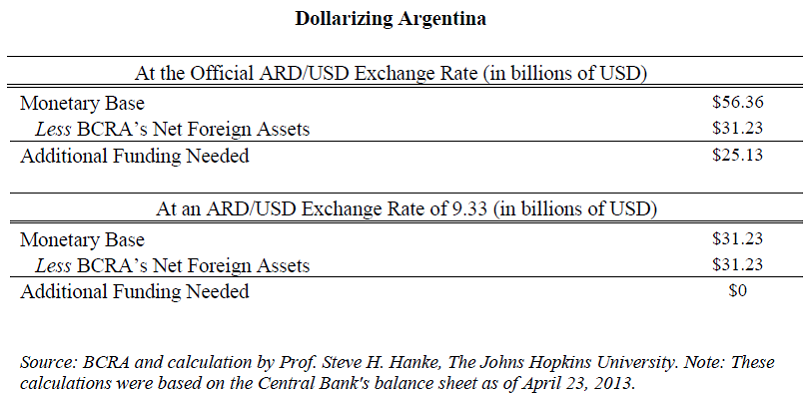
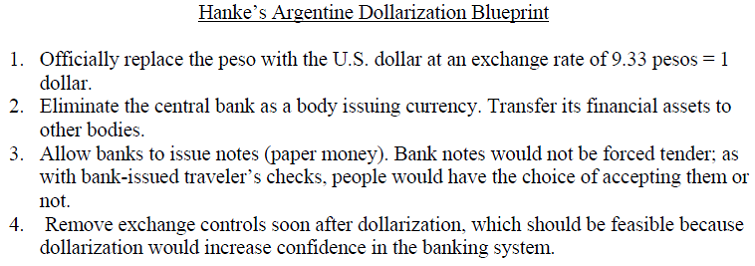

 Anna Björg Hjartardóttir
Anna Björg Hjartardóttir
 Anna Ólafsdóttir Björnsson
Anna Ólafsdóttir Björnsson
 Axel Jóhann Axelsson
Axel Jóhann Axelsson
 Axel Þór Kolbeinsson
Axel Þór Kolbeinsson
 Benedikta E
Benedikta E
 Bjarni Harðarson
Bjarni Harðarson
 Eggert Guðmundsson
Eggert Guðmundsson
 Einar Björn Bjarnason
Einar Björn Bjarnason
 Einar Gunnar Birgisson
Einar Gunnar Birgisson
 Elle_
Elle_
 Emil Örn Kristjánsson
Emil Örn Kristjánsson
 Eyþór Laxdal Arnalds
Eyþór Laxdal Arnalds
 Friðrik Hansen Guðmundsson
Friðrik Hansen Guðmundsson
 Frosti Sigurjónsson
Frosti Sigurjónsson
 Geir Ágústsson
Geir Ágústsson
 Gunnar Heiðarsson
Gunnar Heiðarsson
 Gunnar Rögnvaldsson
Gunnar Rögnvaldsson
 Gunnar Skúli Ármannsson
Gunnar Skúli Ármannsson
 Gunnlaugur I.
Gunnlaugur I.
 Guðmundur Jónas Kristjánsson
Guðmundur Jónas Kristjánsson
 Guðmundur Kjartansson
Guðmundur Kjartansson
 Guðmundur Ásgeirsson
Guðmundur Ásgeirsson
 Guðni Karl Harðarson
Guðni Karl Harðarson
 Guðrún María Óskarsdóttir.
Guðrún María Óskarsdóttir.
 Guðrún Sæmundsdóttir
Guðrún Sæmundsdóttir
 Gústaf Adolf Skúlason
Gústaf Adolf Skúlason
 Haraldur Baldursson
Haraldur Baldursson
 Haraldur Hansson
Haraldur Hansson
 Haraldur Haraldsson
Haraldur Haraldsson
 Helga Kristjánsdóttir
Helga Kristjánsdóttir
 Helga Þórðardóttir
Helga Þórðardóttir
 Hjörleifur Guttormsson
Hjörleifur Guttormsson
 Ingibjörg Guðrún Magnúsdóttir
Ingibjörg Guðrún Magnúsdóttir
 Jakobína Ingunn Ólafsdóttir
Jakobína Ingunn Ólafsdóttir
 Jóhann Páll Símonarson
Jóhann Páll Símonarson
 Jón Baldur Lorange
Jón Baldur Lorange
 Jón Lárusson
Jón Lárusson
 Jón Magnússon
Jón Magnússon
 Jón Ríkharðsson
Jón Ríkharðsson
 Jón Valur Jensson
Jón Valur Jensson
 Kjartan Eggertsson
Kjartan Eggertsson
 Kolbrún Hilmars
Kolbrún Hilmars
 Kristbjörg Þórisdóttir
Kristbjörg Þórisdóttir
 Kristin stjórnmálasamtök
Kristin stjórnmálasamtök
 Kristinn Snævar Jónsson
Kristinn Snævar Jónsson
 Kristján P. Gudmundsson
Kristján P. Gudmundsson
 Ragnar Þór Ingólfsson
Ragnar Þór Ingólfsson
 Ragnhildur Kolka
Ragnhildur Kolka
 S i g u r ð u r S i g u r ð a r s o n
S i g u r ð u r S i g u r ð a r s o n
 Samtök um rannsóknir á ESB ...
Samtök um rannsóknir á ESB ...
 Sigurbjörg Eiríksdóttir
Sigurbjörg Eiríksdóttir
 Sigurjón Þórðarson
Sigurjón Þórðarson
 Sigurður Sigurðsson
Sigurður Sigurðsson
 Sigurður Þórðarson
Sigurður Þórðarson
 Tryggvi Helgason
Tryggvi Helgason
 Valan
Valan
 Valdimar Samúelsson
Valdimar Samúelsson
 Viggó Jörgensson
Viggó Jörgensson
 Vilhjálmur Örn Vilhjálmsson
Vilhjálmur Örn Vilhjálmsson
 au
au
 Ásthildur Cesil Þórðardóttir
Ásthildur Cesil Þórðardóttir
 Ægir Óskar Hallgrímsson
Ægir Óskar Hallgrímsson
 Ívar Pálsson
Ívar Pálsson
 Ólafur Örn Jónsson
Ólafur Örn Jónsson
 Óskar Helgi Helgason
Óskar Helgi Helgason
 Óðinn Þórisson
Óðinn Þórisson
 Örn Ægir Reynisson
Örn Ægir Reynisson
 ÞJÓÐARHEIÐUR - SAMTÖK GEGN ICESAVE
ÞJÓÐARHEIÐUR - SAMTÖK GEGN ICESAVE
 Þráinn Jökull Elísson
Þráinn Jökull Elísson
 Þórólfur Ingvarsson
Þórólfur Ingvarsson
 Högni Snær Hauksson
Högni Snær Hauksson
 Íslenska þjóðfylkingin
Íslenska þjóðfylkingin
 Jóhann Kristinsson
Jóhann Kristinsson
 Jón Valur Jensson
Jón Valur Jensson
 Lífsréttur
Lífsréttur
